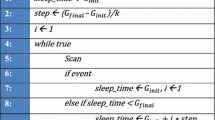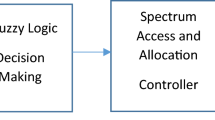Abstract
Third generationUmts network has come with significant high-quality services that considerably increase the complexity of its management. Autonomic management has been introduced to alleviate these complex lengthy tasks. In this paper, we propose an autonomic management of macro-diversity algorithm inUmts networks. The new approach allows to dynamically adapt macro-diversity parameters to varying network situations. The online adaptation of these parameters is made by an intelligent controller calledfuzzy-Q-Learning. The combination of Fuzzy Inference System (Fis) and Q-learning algorithm allows to determine the best on-line parameterization of base stations and to deal with large number of continuous states and actions. The proposed scheme improves the system capacity up to 30% compared to a classical network with fixed parameters, balances the load between base stations and minimizes human interventions in the network management. However, the reactivity of the controller should be chosen with a special care since it impacts the frequency of active set updates and hence signalling messages in the radio interface as well as in the core network.
Résumé
Les réseaux mobilesUmts de troisième génération offrent un haut niveau de qualité de service qui complique de plus en plus le management des ressources radios. L’introduction du processus de management autonome dans ces réseaux permet de réduire considérablement cette complexité. Dans cet article, nous proposons une nouvelle méthode pour le réglage autonome des paramètres de macro-diversité d’un réseauUmts. Cette nouvelle approche permet d’adapter dynamiquement les paramètres en fonction de la situation du réseau en termes de fluctuations de trafic et de types de mobilité. Le réglage automatique et autonome de ces paramètres est réalisé par un contrôleur de typefuzzy-Q-Learning. Ce contrôleur combine un système d’inférence floue (Sif) et un algorithme d’apprentissage par renforcement. Cette combinaison permet au contrôleur de trouver dynamiquement le meilleur paramétrage pour chaque station de base et de traiter des états et des actions continus. Cette méthode augmente la capacité du système jusqu ’à 30 % par rapport à un réseau classique, permet d’équilibrer la charge entre les stations de base et diminue l’intervention humaine dans la tache de management du réseau. Cependant, La réactivité du contrôleur doit être prudemment choisie car elle influe la fréquence des mises à jour de l’active set du mobile qui se traduit par une augmentation des messages de signalisation au niveau de l’interface radio ainsi que du réseau cœur.
Similar content being viewed by others
References
Altman (Z.),Dubreil (H.),Nasri (R.),Ben Amor (O.),Picard (J. M.),Diascorn (V.), Clerc (M.), “Auto-tuning ofRrm parameters inUmts networks”, book chapter in UnderstandingUmts Radio Network Modelling, Planning and Automated Optimisation: Theory and Practice,Wiley & Sons, Editors: M. J. Nawrocki, M. Dohler, A. H. Aghvami, 2006.
3Gpp tr 25.922 (Release 6.1.0): “Radio Resource Management Strategies”
Ahmed (M. H.), “Call Admission Control in Wireless networks, A Comprehensive Survey”,IEEE Communications Surveys and Tutorials,7, no 1, 1st Quarter 2005, pp. 2–21.
Ben Jamaa (S.),Altman (Z.),Picard (J. M.),Fourestie (B.),Mourlon (J.), “Manual and automatic design forUmts networks”,10, No. 2,Mobile Networks and Applications, April 2004.
Hampel (G.),Abush-Magder (D.),Diaz (A.),Drabeck (L. M.),Flanagan (M. J.),Graybeal (J. M.),Hobby (J. D.),MacDonald (M.),Polakos (P. A.),Srinivasan (J.),Trickey (H.),Zhang (L.),Rittenhouse (G.), “The New Paradigm for Wireless Network Optimization: A Synergy of Automated Processes and Human Intervention”,IEEE Communications Magazine,43, no 3, March 2005.
Laiho (J.),Wacker (A.),Novosad (T.), Radio Network Planning and Optimisation forUmts,John Wiley & Sons, 2002.
Stuckmann (P.),Altman (Z.),Dubreil (H.),Ortega (A.),Barco (R.),Toril (M.),Fernandez (M.),Bary (M.),Mcorath (S.),Blyth (G.),Saidha (P.),Nielsen (L. M.), “TheEureka Gandalf project: monitoring and self-tuning techniques for heterogeneous radio access networks”, IEEE International SymposiumVrc 2005, Stockholm, Sweden, 29 May–1 June 2005.
Dubreil (H.),Altman (Z.),Diascorn (V.),Picard (J. M.),Clerc (M.), “Particle Swarm optimization of fuzzy logic controller for high qualityRrm auto-tuning ofUmts networks”, IEEE International SymposiumVtc 2005, Stockholm, Sweden, 29 May–1 June 2005.
Edwards (G.),Sankar (R.), “Handoff using fuzzy logic”,IEEE Globecom, Singapore, pp. 520–524, November 1995.
Edwards (G.), Sankar (R.), “Microcellular Handoff Using Fuzzy Techniques”,Wireless Networks,4, no 5, pp. 401–409, 1998.
Jouffe (L.), “Fuzzy Inference System Learning by reinforcement Methods”,IEEE Transactions on Systems, Man, and Cybernetics,28, pp. 338–355, August 1998.
Glorennec (P. Y.), Apprentissage par renforcement et logique floue, in Actes des rencontres francophones sur la logique floue et ses applications (Lfa’01), November 2001.
Holma (H.),Toskala (A.), “Wcdma forUmts: Radio Access for Third Generation Mobile Communications”,Wiley & Sons, 2001.
Dini (P.), Guglielmucci (S.), “A call admission control strategy based on fuzzy logic forWcdma systems”,IEEE International Conference on Communications,4, pp. 2332–2336, June 2004.
Homnan (B.), Benjapolakul (W.), “QoS-controlling soft handoff based on simple step control and a fuzzy inference system with the gradient descent method”,IEEE Transactions on Vehicular Technology,53, pp. 820–834, May. 2004.
Ye (J.), Shen (X.), Mark (J. W.), “Call Admission Control in WidebandCdma Cellular Networks by using Fuzzy Logic”,IEEE Transactions on Mobile Computing,4, no 2, pp. 129–141, April. 2005.
Zhang (W.), “Handover Decision Using FuzzyMadm in Heterogeneous Networks”, IEEE Wireless Communications and Networking Conference 2004 (Wcnc 2004), Atlanta, USA, Mar. 2004.
Agusti (R.),Sallent (O.),Pérez-Romero (J.),Giupponi (L.), “A Fuzzy-Neural Based Approach for Joint Radio Resource Management in a Beyond 3G Framework”, First International Conference on Quality of Service in Heterogeneous Wired/Wireless Networks (Qsmne’04), Dallas, Texas. Oct. 2004.
Senouci (S. M.),Beylot (A. L.),Pujolle (G.), “Call admission control in cellular networks: a reinforcement learning solution”,International Journal of Network Management, no 14, pp 89–103, 2004.
Yu (F.),Wong (V. W. S.),Leung (V. C. M.), “Efficient QoS Provisioning for Adaptative Multimedia in Mobile Communication Networks by reinforcement Learning”, First International Conference on Broadband Networks,Broadnets’04 IEEE, 2004.
Yu (F.),Wong (V. W. S.),Leung (V. C. M.), “A New QoS Provisioning Method for Adaptive Multimedia in Cellular Wireless Networks”, IEEE Conference on Computer Communications (Infocom’04), Hong Kong, China, March 2004.
Chen (Y. S.), Chang (C. J.), Ren (F. C.), “A Q-learning-based multi-rate transmission control scheme forRrm in multimediaWcdma systems”,IEEE Transactions on Vehicular Technology,53, no 1, pp. 38–48, Jan. 2004.
Berenji (H. R.), Khedkar (P.), “Learning and tuning fuzzy logic controllers through reinforcements”,IEEE Transactions on Neural Networks,3, no 5, Page.724–740, Sept. 1992.
Takagi (T.),Sugeno (M.), “Fuzzy identification of systems and its application to modeling and control”,IEEE Transactions on Systems, Man, and Cybernetics,Smc-15, pp. 116–132, Jan. 1985.
Author information
Authors and Affiliations
Rights and permissions
About this article
Cite this article
Nasri, R., Altman, Z. & Dubreil, H. Fuzzy-Q-learning-based autonomic management of macro-diversity algorithm in UMTS networks. Ann. Télécommun. 61, 1119–1135 (2006). https://doi.org/10.1007/BF03219884
Received:
Accepted:
Issue Date:
DOI: https://doi.org/10.1007/BF03219884
Key words
- Mobile radiocommunication
- Umts
- Network management
- Autonomous system
- Fuzzy logic
- Machine learning
- Diversity
- Adjustment
- Networking
- Cellular network




